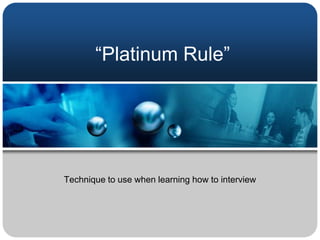Platinum Rule Communication Styles
•Als PPTX, PDF herunterladen•
1 gefällt mir•1,373 views
The "Platinum Rule" for interviewing is to do unto others as they would have you do unto them. To apply this rule, one should discover their own communication style, quickly recognize others' styles, and modify their communication to adapt to the other person's style. The document describes four communication styles - Driver, Expressive, Amiable, and Analytical - that are determined based on a person's level of assertiveness and responsiveness.
Melden
Teilen
Melden
Teilen

Empfohlen
Empfohlen
Weitere ähnliche Inhalte
Was ist angesagt?
Was ist angesagt? (20)
141. Assertive Tech and Practice explained by S. Lakshmanan, Psychologist

141. Assertive Tech and Practice explained by S. Lakshmanan, Psychologist
Ähnlich wie Platinum Rule Communication Styles
Ähnlich wie Platinum Rule Communication Styles (20)
Improving Project Team Communication - Smith Culp Consulting

Improving Project Team Communication - Smith Culp Consulting
Hi all i need help to write this essay please I would greatly apprec.pdf

Hi all i need help to write this essay please I would greatly apprec.pdf
presentation_listening_skills_1495999304_244125.pdf

presentation_listening_skills_1495999304_244125.pdf
Platinum Rule Communication Styles
- 1. “Platinum Rule” Technique to use when learning how to interview
- 2. “Platinum Rule” What is it “Do unto others as they would have you do unto them”.
- 3. “Platinum Rule” • Three things to know to use it 1. Your own way of communications 2. Quickly recognizing others’ way of communication 3. How to modify your own communications to adapt to others communications
- 4. Discover Your Communication Style • This brief assay will help you determine your most comfortable way of communicating
- 5. How the 4 styles are derived • Assertiveness • Responsiveness – A measure of the degree – A measure of the degree to to which a person which a person responds to influences other people by other people’s comments. what he or she says. At At one end of the axis is one end of the axis is Tell Control Responsive: these Assertive: these people tell people use factual, precise what they think. At the words, their body language other end is Ask Assertive: is reserved and their facial these people ask others’ expressions stay the same thoughts before telling their no matter the topic. At the own thoughts. other end is Emote Responsive: these people convey what they think with facial expressions, colorful words with lots of adjectives and very open body language.
- 6. How the 4 styles are derived
- 7. Driver Attributes • Focus on one thing at a time and talk about one point at a time • Make use of schedules, agendas, “to-do” lists • Thinks in the immediate present • Uses primarily nouns & verbs • Can appear rude, hard, cold • Rarely speaks about personal things
- 8. Expressive Attributes • Jump from thought to thought • Appears to never finish anything or any topic • Uses lots of adjectives & adverbs • Makes wide arm movements • Welcomes your participation in their thinking & problem- solving process
- 9. Amiable Attributes • Uses descriptive sentences • Speaks very calmly & slowly • Asks lots of questions about what other people think or how they did things • Takes a long time to make decisions • Faces of amiables are very expressive • Has a hard time saying no
- 10. Analytical Attributes • Uses precise, specific words and facts, figures, reason & logic • Likes lots of information • Wants to make a perfect decision • Has a hard time with things that are new or changes • Asks for lots of information • Rarely speaks about personal matters • Speaks deliberately, obviously choosing their words carefully • Appears calm in any interview • Rarely shows outward enthusiasm
- 11. Recognizing Styles • Can you recognize which communication style is being used from these phrases we’ve all heard before.